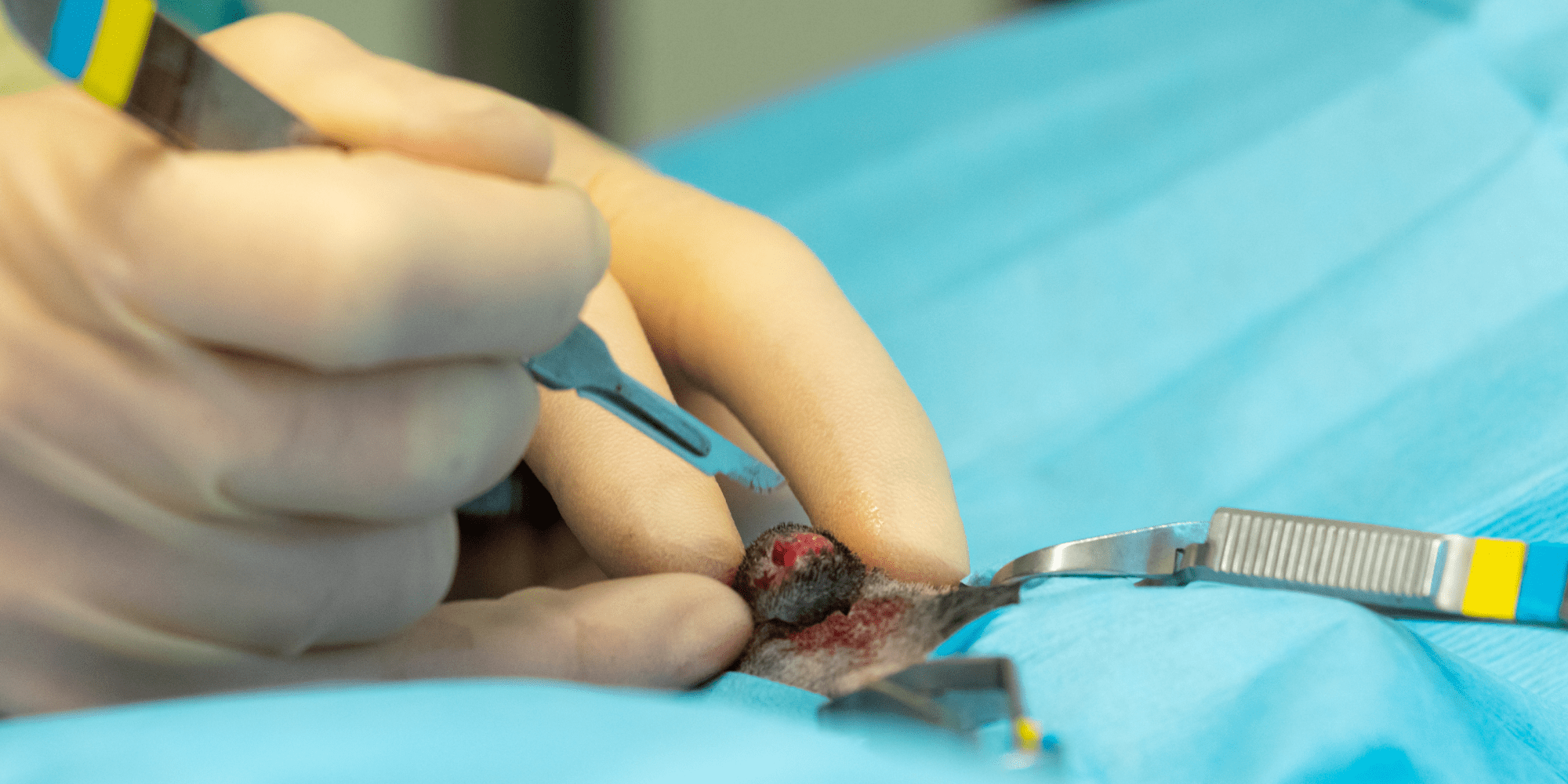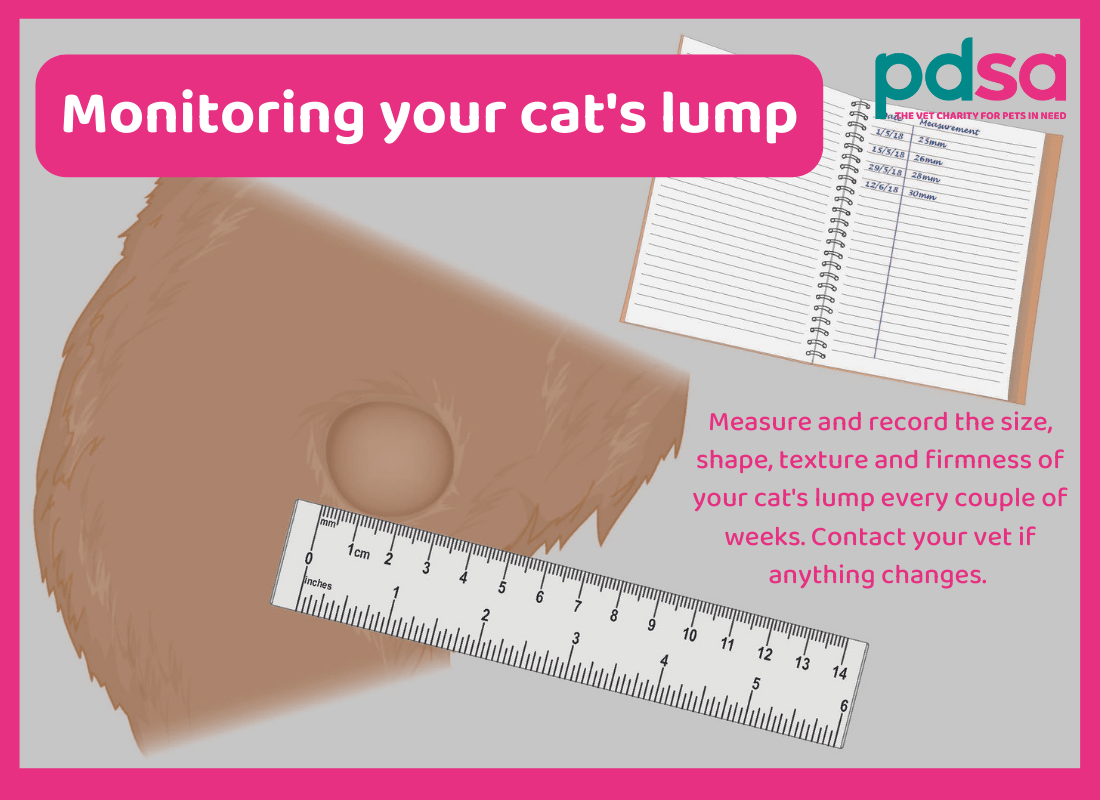Skin lumps in cats
Overview
- It can be worrying to find a lump on your cat, but it’s important to remember that not all lumps are cancerous.
- It’s sensible to regularly check your cat for lumps and book an appointment with your vet if you find one, even if it looks harmless.
- Most lumps look similar from the outside so your vet may need to take a sample of your cat’s lump to find out what it is.
Types of lump
Some of the most common lumps found on cats include:
Abscesses – pockets of pus that usually appear quickly and are extremely tender. Cats often develop abscesses after fighting with other cats, which is why we call them cat bite abscesses.
Cysts – harmless, soft, fluid-filled pockets that don’t cause any pain and usually appear quickly. Cysts can change shape and size over time.
Haematomas – a blood-filled swelling, usually caused by an injury, after a surgery, or sometimes (much more rarely) because of a clotting problem.
Skin rashes – many skin problems in cats can cause rashes, lumps and bumps, for example, feline eosinophilic dermatitis and allergic skin disease.
Non-cancerous tumours – non-cancerous (benign) tumours tend to be slow-growing and don’t spread to the rest of the body. They don’t usually cause problems unless they get in the way of other body parts, cause irritation/pain or become infected. Some of the benign tumours that can affect cats include:
- Lipomas (fatty lumps) – lipomas are soft, slow-growing lumps made of fatty tissue. They are uncommon in cats but are slightly more common in Siamese.
- Basal cell tumours – basal cell tumours tend to be slow-growing, dome-shaped, and usually appear on the head, neck, shoulders or back. They are often hairless, and sometimes become ulcerated. Most basal cell tumours in cats are benign but some can be malignant.
Cancerous tumours – cancerous (malignant) tumours tend to grow quickly and spread to other parts of the body. Some of the most common skin cancers in cats include:
- Squamous cell carcinomas – a skin cancer caused by sunlight damage, common on the ear tips, nose, and eyelids, especially in cats with light-coloured fur/skin. These tend to grow quickly in one area but are slow to spread around the body.
- Mast cell tumours – mast cell tumours vary in appearance and often grow and shrink in size. In cats, they usually occur as a single lump and are slow to spread. Mast cell tumours can also occur internally in the spleen and intestines.
- Fibrosarcoma – fibrosarcomas are a type of tumour most commonly found on the head or legs. They tend to grow slowly and are slow to spread but, eventually, become very large and ulcerated. Injection site sarcomas are a type of fibrosarcoma that can form after a cat has had an injection under the skin.

It may not be particularly easy for your vet to tell you what your cat’s lump is just by looking at it so, unless it’s obvious, it’s likely that they will need to run some tests to get a diagnosis. This may involve taking a sample of the lump with a needle and syringe (a fine needle aspirate), a surgical biopsy of the lump, or even removing the lump completely. Some tests may be run at the practice, while other samples might need to be sent to a special laboratory.

It’s a good idea to check your cat for lumps regularly. Run your hands over their whole body, and if you find a lump or swelling then take a photo, make a note of how big it is by measuring it with a ruler and book an appointment with your vet. Every lump should be checked, even if it looks harmless or your cat has had lumps before. This is because each new lump has the potential to be different from the last one. If your vet has asked you to monitor a lump, take photographs and measure it every couple of weeks. It can also be helpful to make notes about the following:
- Its shape
- Its texture (smooth or knobbly)
- How hard/soft it is
- Whether it’s causing pain or not
- Whether it bleeds or weeps
If the lump changes, book a check-up appointment with your vet.
Published: March 2023
Did you find this page useful?
Tell us more
Please note, our vets and nurses are unable to respond to questions via this form. If you are concerned about your pet’s health, please contact your vet directly.
Thank you for your feedback
Want to hear more about PDSA and get pet care tips from our vet experts?
Sign up to our e-newsletter
Written by vets and vet nurses. This advice is for UK pets only. Illustrations by Samantha Elmhurst.

